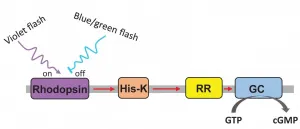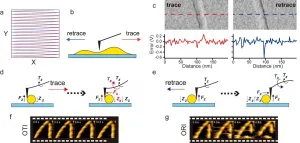Carbon labeling reduces our CO2 footprint -- even for those who try to remain uninformed
2021-03-29
(Press-News.org) Climate labels informing us of a meat product's carbon footprint cause many people to opt for climate-friendlier alternatives. This applies to people who are curious about a product's carbon footprint, as well as to those who actively avoid wanting to know more. The finding is published in a new study from, among others, the University of Copenhagen. As such, climate labeling food products can be a good way of reducing our climate footprint. But according to the researcher behind the study, labels must be obligatory for them to be effective.
Certain situations exist where we humans strategically avoid greater knowledge and more information - a phenomenon known as "active information avoidance". It could be that we don't want to know how many calories are in the bag of chips that we've just opened. Or, that we avoid going to the doctor because we fear a certain diagnosis.
But it can also have to do with us not wanting to know about how what we shop for at the supermarket impacts the climate. This is the finding from a new study conducted by the University of Copenhagen and Swedish University of Agricultural Sciences, who investigated the efficacy of climate impact information as a way to influence consumer choice.
"Our experiments demonstrate that one out of three people doesn't want to know the climate impact of the food they eat. But at the same time, we can see that there is a psychological effect when people are informed on its climate impact, in so far as more people end up buying a less CO2 heavy product," says Associate Professor Jonas Nordström of the University of Copenhagen's Department of Food and Resource Economics.
Information could have a cost
In the experiment, 803 participants were asked to choose between six alternatives consisting of variations of ground meat and a plant-based mixture, each without a climate label. The participants were then asked whether or not they wanted to know the climate information for the products. Thirty-three percent of the participants said no. All of them were then asked to make new choices, where the products now had a label with their CO2 information.
For those who said yes to the information, there was a 32 percent reduction in the climate footprint through their new product choices, while the "information avoiders" collectively reduced their footprint by 12 percent after being exposed to the climate labeling.
Hence, the researchers believe that a portion of the information avoiders actively chose to opt out of more information as a way of remaining unknowledgeable - for example to avoid any inner conflict between what they want to do and what they ought to do.
"Our assumption is that being aware of a product's climate impact has a psychological cost for the consumer. If someone who enjoys red meat is informed of its climate impact, it may prompt them to feel a bit of shame or have a guilty conscience. By actively opting out of this information, it becomes less uncomfortable to make a choice that would be seen as a climate sin," explains Associate Professor Nordström, who adds:
"However, if information about the climate impact is forced upon the consumer, some will opt to buy chicken instead of beef, and in so doing, mitigate some of the negative feelings associated with making a decision that has a greater climate consequence. In our experiment, this resulted in a 12 percent lower carbon footprint."
Climate labeling ought to be obligatory
While some Danish supermarkets have begun to inform consumers about the climate effects of their purchasing decisions, there are few products with labeled CO2 footprint information. The researchers believe that the study's results can be used as an argument for implementing obligatory climate information on foodstuffs.
"Climate-labeling clearly effects consumers - both those people who are keen to be aware of the climate impact, as well as those who actively seek to ignore this sort of knowledge. The study demonstrates that the latter group can only be affected if they are provided with the information. For climate labeling to be effective, it needs to be obligatory as certain producers of climate threatening products won't voluntarily provide their products with this type of information," says Jonas Nordström.
He adds that the effect could be even greater if there is a simultaneous drive towards informing the public that everyone's contribution is important when it comes to achieving climate goals.
INFORMATION:
It should be noted that the study is based upon hypothetical purchasing decisions among Swedish consumers. Thus, the results should therefore be verified among Danish consumers in an in-store experiment.
ABOUT THE STUDY:
* The study is published in the journal Food Policy: https://www.sciencedirect.com/science/article/pii/S0306919221000142/
* The researchers behind the study are Anna Kristina Edenbrandt and Carl Johan Lagerkvist of the Swedish University of Agricultural Sciences, along with Jonas Nordström of the University of Copenhagen.
* The researchers identified two primary motivations that impacted participant behavior when it came to a labeled CO2 footprint. One is cognitive dissonance, occurring as a result from being exposed to information that conflicts with one's prior beliefs that cause unpleasant emotions/mental discomfort. The other motivation is a feeling of responsibility and personal norms. The researchers found that both motivations affected how a person reacts to information. People who experience a high degree of one or both motivations are more likely to change their consumptive behaviour in a more climate-friendly direction when informed about the carbon footprint of products.
ELSE PRESS RELEASES FROM THIS DATE:
2021-03-29
The unicellular green alga Chlamydomonas reinhardtii has already given research a massive boost: One of its light sensors, channelrhodopsin-2, founded the success of optogenetics about 20 years ago.
In this technology, the alga's light sensor is incorporated into cells or small living organisms such as threadworms. Afterwards, certain physiological processes can be triggered or stopped by light. This has already led to several new scientific findings, for example on the function of nerve cells.
Now the green alga Chlamydomonas is once again setting an accent. Once again, it is its light sensors, ...
2021-03-29
High-speed atomic force microscopy (HS-AFM) is an imaging technique that can be used for visualizing biological processes, for example the activity of proteins. Nowadays, typical HS-AFM frame rates are as high as 12 frames per second. In order to improve the capabilities of the method, so that it can be applied to an ever expanding range of biological samples, better video rates are needed, though. Moreover, faster recording times imply less interaction between the sample and the probe -- a tip scanning the sample's surface -- making the imaging ...
2021-03-29
A team of researchers, led by the Instituto de Ciencias del Patrimonio (Incipit-CSIC) and the Instituto de Astrofísica de Canarias (IAC), in collaboration with the team from the Arqueological Zone of Caral (Perú) led by Dr. Ruth Shady Solís, has established the relation between the position of the monuments of the Supe Culture (Perú), their orientations, and some astronomical and topographic features, which opens the way to the analysis of the way the inhabitants of this valley conceived space and time 5000 years ago. The results of the study have just been published in the journal Latin American Antiquity.
The valley of the river Supe in Perú contains the first evidence for city building in the Americas. In recent decades in this valley and ...
2021-03-29
Next-gen electronics is envisioned to be non-rigid, component-free, flexible, bendable, and easily integrable with different objects.
Direct-write printing techniques provide unique opportunity to enable this vision through use of nanomaterial so-called functional inks, that can be tailored to add desired functionalities on various flexible substrates, such as textiles or plastic.
The technology, known as Printed Electronics (PE), has been known for decades, but has recently gained considerable attention due to innovation in material inks, process technology and design revolution.
To keep the research community abreast with the latest technological advancements in the area of droplet-based PE techniques for next-gen devices, researchers from Aarhus University have now ...
2021-03-29
Kanazawa, Japan - Solar cells are excellent renewable energy tools that use sunlight to drive an electrical current for power. They've been used to power homes since the 1980s, and their performance and production cost have improved dramatically since then. The most common solar cells, based on silicon, work well for a long time. They retain more than 80% of their functionality even after 25 years. However, the efficiency--i.e., how much of the incoming sunlight is converted to electrical power--of commercial-scale silicon solar cells is currently only around 20%.
Maximizing solar cells' energy conversion efficiency will improve their competitiveness compared to fossil fuels and help optimize them as a sustainable ...
2021-03-29
The B.1.1.7 and B.1.351 variants of SARS-CoV-2 were first detected in the UK and South Africa respectively, and have since spread to many other countries. Scientists from the Institut Pasteur joined forces with Orléans Regional Hospital, Tours University Hospital, Créteil Intercommunal Hospital, Strasbourg University Hospital and Georges Pompidou European Hospital to study the sensitivity of these two variants to neutralizing antibodies present in the serum samples of people who have been vaccinated or previously infected with SARS-CoV-2. They compared this sensitivity with that of the reference ...
2021-03-29
Whether for microscopy, data storage or sensor technology, many advanced technological applications that require specific functions rely on the structure of the electromagnetic field near the surfaces of materials. In nanosystems, so-called surface phonons, i.e. temporal distortions of the atomic lattice, contribute decisively to the physical and thermodynamic properties.
If surface phonons could be specifically manipulated, it would be possible to achieve better thermal conduction or heat transfer between two components with nanosurfaces. This could be used, for example, in detectors, sensors or in highly efficient passive cooling systems. In addition, surface phonons concentrate electromagnetic energy ...
2021-03-29
A paper by the Kavli Institute for the Physics and Mathematics of the Universe (Kavli IPMU) Director Ooguri Hirosi and Project Researcher Matthew Dodelson on the string theoretical effects outside the black hole photon sphere has been selected for the "Editors' Suggestion" of the journal Physical Review D. Their paper was published on March 24, 2021.
In a quantum theory of point particles, a fundamental quantity is the correlation function, which measures the probability for a particle to propagate from one point to another. The correlation function develops singularities when the two points are connected by light-like trajectories. In a flat spacetime, there is such a unique trajectory, but when spacetime is curved, there ...
2021-03-29
The recommendations are clear: physical activity is good for mental health. But it also depends on how varied it is. That's what a new study by researchers at the University of Basel shows, pointing to one of the reasons why well-being suffers during the pandemic.
A walk in the morning, a jog in the evening or even just going out to buy groceries: activity helps the psyche. Many are trying to stay active during the pandemic despite mandatory home office and limited leisure activities. Others find that they are moving significantly less than before the pandemic because previous everyday activities are off-limits due to measures taken against the spread of Covid-19.
Against this backdrop, a study led by Professor Andrew ...
2021-03-29
A new type of universal computer memory - ULTRARAM™ - has taken a step closer towards development with a successful experiment by Lancaster physicists.
Professor Manus Hayne, who is leading the research, commented: "These new results confirm the astonishing properties of ULTRARAM™, allowing us to demonstrate its potential as a fast and efficient non-volatile memory with high-endurance."
Currently, the two main types of memory, dynamic RAM (DRAM) and flash, have complementary characteristics and roles:-
DRAM is fast, so used for active (working) memory but it is volatile, meaning that information is lost when power is removed. Indeed, DRAM continually ...
LAST 30 PRESS RELEASES:
[Press-News.org] Carbon labeling reduces our CO2 footprint -- even for those who try to remain uninformed






